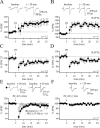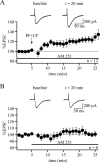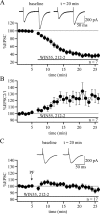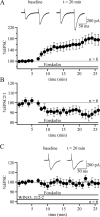Climbing fiber-evoked endocannabinoid signaling heterosynaptically suppresses presynaptic cerebellar long-term potentiation
- PMID: 16899723
- PMCID: PMC6673796
- DOI: 10.1523/JNEUROSCI.0805-06.2006
Climbing fiber-evoked endocannabinoid signaling heterosynaptically suppresses presynaptic cerebellar long-term potentiation
Abstract
Endocannabinoid signaling has been demonstrated to mediate depolarization-induced suppression of excitation at climbing fiber (CF) and parallel fiber (PF) synapses onto cerebellar Purkinje cells. Here, we show that CF-evoked release of cannabinoids (CBs) additionally suppresses a presynaptic form of long-term potentiation (LTP) at PF synapses. PF-LTP can be induced by 8 Hz PF tetanization but is blocked when the PF tetanization is paired with 4 or 1 Hz CF coactivation. CF activity can be substituted for by bath application of the CB receptor agonist WIN55,212-2 [R(+)-[2,3-dihydro-5-methyl-3-[(morpholinyl)methyl]pyrrolo[1,2,3-de]-1,4-benzoxazinyl]-(1-naphthalenyl) methanone]. In the presence of the CB1 receptor antagonist AM251 [N-1-(2,4-dichlorophenyl)-5-(4-iodophenyl)-4-methyl-N-1-piperidinyl-1H-pyrazole-3-carboxamide], CF activity no longer suppresses PF-LTP. Presynaptic potentiation can also be obtained by the adenylyl cyclase activator forskolin. WIN55,212-2 blocked this forskolin-mediated enhancement, showing that CB1 receptor activation interferes with the adenylyl cyclase-protein kinase A cascade, which participates in LTP induction. CF activity has been described to promote the induction of postsynaptic PF-long-term depression (LTD) and to impair postsynaptic PF-LTP. Our observation that CF activity blocks the induction of presynaptic LTP suggests that the CF input controls all forms of presynaptic and postsynaptic PF plasticity and that CF activity provides a "safety lock" to prevent an enhancement of transmitter release while postsynaptic AMPA receptor function is downregulated during LTD.
Figures




Similar articles
-
Long-term potentiation at cerebellar parallel fiber-Purkinje cell synapses requires presynaptic and postsynaptic signaling cascades.J Neurosci. 2014 Feb 5;34(6):2355-64. doi: 10.1523/JNEUROSCI.4064-13.2014. J Neurosci. 2014. PMID: 24501374 Free PMC article.
-
Muscarinic acetylcholine receptor activation blocks long-term potentiation at cerebellar parallel fiber-Purkinje cell synapses via cannabinoid signaling.Proc Natl Acad Sci U S A. 2013 Jul 2;110(27):11181-6. doi: 10.1073/pnas.1221803110. Epub 2013 Jun 17. Proc Natl Acad Sci U S A. 2013. PMID: 23776234 Free PMC article.
-
Role of presynaptic kainate receptors at parallel fiber-purkinje cell synapses in induction of cerebellar LTD: interplay with climbing fiber input.J Neurophysiol. 2009 Aug;102(2):965-73. doi: 10.1152/jn.00269.2009. Epub 2009 Jun 17. J Neurophysiol. 2009. PMID: 19535482
-
On the induction of postsynaptic granule cell-Purkinje neuron LTP and LTD.Cerebellum. 2010 Sep;9(3):284-90. doi: 10.1007/s12311-010-0174-9. Cerebellum. 2010. PMID: 20446074 Free PMC article. Review.
-
Endocannabinoid signaling and synaptic plasticity in the brain.Crit Rev Neurobiol. 2006;18(1-2):113-24. doi: 10.1615/critrevneurobiol.v18.i1-2.120. Crit Rev Neurobiol. 2006. PMID: 17725514 Review.
Cited by
-
Long-term potentiation at cerebellar parallel fiber-Purkinje cell synapses requires presynaptic and postsynaptic signaling cascades.J Neurosci. 2014 Feb 5;34(6):2355-64. doi: 10.1523/JNEUROSCI.4064-13.2014. J Neurosci. 2014. PMID: 24501374 Free PMC article.
-
The Endocannabinoid System as Pharmacological Target Derived from Its CNS Role in Energy Homeostasis and Reward. Applications in Eating Disorders and Addiction.Pharmaceuticals (Basel). 2011 Aug 10;4(8):1101-1136. doi: 10.3390/ph4081101. Pharmaceuticals (Basel). 2011. PMID: 32143540 Free PMC article. Review.
-
Asymmetries in Cerebellar Plasticity and Motor Learning.Cerebellum. 2016 Apr;15(2):87-92. doi: 10.1007/s12311-014-0635-7. Cerebellum. 2016. PMID: 25578035 Free PMC article. Review.
-
Presynaptically expressed long-term depression at cerebellar parallel fiber synapses.Pflugers Arch. 2009 Feb;457(4):865-75. doi: 10.1007/s00424-008-0555-9. Epub 2008 Jul 29. Pflugers Arch. 2009. PMID: 18663469
-
Deletion of Endocannabinoid Synthesizing Enzyme DAGLα in Pcp2-Positive Cerebellar Purkinje Cells Decreases Depolarization-Induced Short-Term Synaptic Plasticity, Reduces Social Preference, and Heightens Anxiety.eNeuro. 2025 Jul 23;12(7):ENEURO.0400-24.2025. doi: 10.1523/ENEURO.0400-24.2025. Print 2025 Jul. eNeuro. 2025. PMID: 40523777 Free PMC article.
References
Publication types
MeSH terms
Substances
LinkOut - more resources
Full Text Sources
